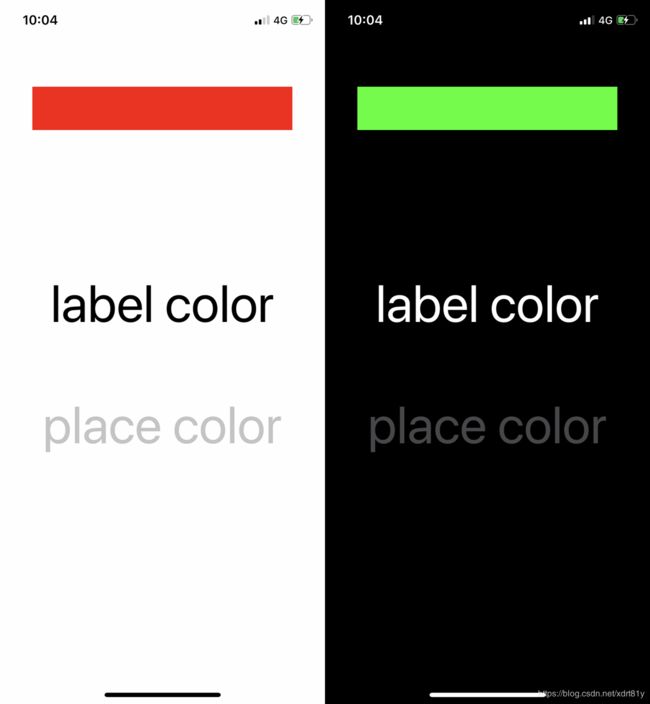iOS13适配之暗黑模式(Dark Mode)
如果是老项目,改动太多,不想适配暗黑模式的话,有个偷懒的方法。或者还没适配完又不想给用户看,可以先暂时全局关闭暗黑模式:在 Info.plist 文件中,添加 key 为 User Interface Style,类型为 String,value 设置为 Light 即可。
追求极致体验,就要完全适配,所有页面没适配好的统统适配一遍,分为以下几种情况。
- 一、适配Dark Mode
- 颜色适配
- 图片适配
- 二、获取当前模式(Light or Dark)
- 三、其他内容
- 四、总结
首先看看我们的效果图:
适配效果图
一、适配Dark Mode
开发者主要从颜色和图片两个方面进行适配,我们不需要关心切换模式时该如何操作,这些都由系统帮我们实现
1 颜色适配
- iOS13 之前
UIColor只能表示一种颜色,而从 iOS13 开始UIColor是一个动态的颜色,在Light Mode和Dark Mode可以分别设置不同的颜色。 - iOS13系统提供了一些动态颜色
@property (class, nonatomic, readonly) UIColor *systemBrownColor API_AVAILABLE(ios(13.0), tvos(13.0)) API_UNAVAILABLE(watchos);
@property (class, nonatomic, readonly) UIColor *systemIndigoColor API_AVAILABLE(ios(13.0), tvos(13.0)) API_UNAVAILABLE(watchos);
@property (class, nonatomic, readonly) UIColor *systemGray2Color API_AVAILABLE(ios(13.0)) API_UNAVAILABLE(tvos, watchos);
@property (class, nonatomic, readonly) UIColor *systemGray3Color API_AVAILABLE(ios(13.0)) API_UNAVAILABLE(tvos, watchos);
@property (class, nonatomic, readonly) UIColor *systemGray4Color API_AVAILABLE(ios(13.0)) API_UNAVAILABLE(tvos, watchos);
@property (class, nonatomic, readonly) UIColor *systemGray5Color API_AVAILABLE(ios(13.0)) API_UNAVAILABLE(tvos, watchos);
@property (class, nonatomic, readonly) UIColor *systemGray6Color API_AVAILABLE(ios(13.0)) API_UNAVAILABLE(tvos, watchos);
@property (class, nonatomic, readonly) UIColor *labelColor API_AVAILABLE(ios(13.0), tvos(13.0)) API_UNAVAILABLE(watchos);
@property (class, nonatomic, readonly) UIColor *secondaryLabelColor API_AVAILABLE(ios(13.0), tvos(13.0)) API_UNAVAILABLE(watchos);
@property (class, nonatomic, readonly) UIColor *tertiaryLabelColor API_AVAILABLE(ios(13.0), tvos(13.0)) API_UNAVAILABLE(watchos);
@property (class, nonatomic, readonly) UIColor *quaternaryLabelColor API_AVAILABLE(ios(13.0), tvos(13.0)) API_UNAVAILABLE(watchos);
@property (class, nonatomic, readonly) UIColor *linkColor API_AVAILABLE(ios(13.0), tvos(13.0)) API_UNAVAILABLE(watchos);
@property (class, nonatomic, readonly) UIColor *placeholderTextColor API_AVAILABLE(ios(13.0), tvos(13.0)) API_UNAVAILABLE(watchos);
@property (class, nonatomic, readonly) UIColor *separatorColor API_AVAILABLE(ios(13.0), tvos(13.0)) API_UNAVAILABLE(watchos);
@property (class, nonatomic, readonly) UIColor *opaqueSeparatorColor API_AVAILABLE(ios(13.0), tvos(13.0)) API_UNAVAILABLE(watchos);
@property (class, nonatomic, readonly) UIColor *systemBackgroundColor API_AVAILABLE(ios(13.0)) API_UNAVAILABLE(tvos, watchos);
@property (class, nonatomic, readonly) UIColor *secondarySystemBackgroundColor API_AVAILABLE(ios(13.0)) API_UNAVAILABLE(tvos, watchos);
@property (class, nonatomic, readonly) UIColor *tertiarySystemBackgroundColor API_AVAILABLE(ios(13.0)) API_UNAVAILABLE(tvos, watchos);
@property (class, nonatomic, readonly) UIColor *systemGroupedBackgroundColor API_AVAILABLE(ios(13.0)) API_UNAVAILABLE(tvos, watchos);
@property (class, nonatomic, readonly) UIColor *secondarySystemGroupedBackgroundColor API_AVAILABLE(ios(13.0)) API_UNAVAILABLE(tvos, watchos);
@property (class, nonatomic, readonly) UIColor *tertiarySystemGroupedBackgroundColor API_AVAILABLE(ios(13.0)) API_UNAVAILABLE(tvos, watchos);
@property (class, nonatomic, readonly) UIColor *systemFillColor API_AVAILABLE(ios(13.0)) API_UNAVAILABLE(tvos, watchos);
@property (class, nonatomic, readonly) UIColor *secondarySystemFillColor API_AVAILABLE(ios(13.0)) API_UNAVAILABLE(tvos, watchos);
@property (class, nonatomic, readonly) UIColor *tertiarySystemFillColor API_AVAILABLE(ios(13.0)) API_UNAVAILABLE(tvos, watchos);
@property (class, nonatomic, readonly) UIColor *quaternarySystemFillColor API_AVAILABLE(ios(13.0)) API_UNAVAILABLE(tvos, watchos);
① 实例
[self.view setBackgroundColor:[UIColor systemBackgroundColor]];
[self.titleLabel setTextColor:[UIColor labelColor]];
[self.detailLabel setTextColor:[UIColor placeholderTextColor]];
② 效果展示
系统UIColor样式
用法和iOS13之前的一样,使用系统提供的这些动态颜色,不需要其他的适配操作
③ 自定义动态UIColor
在实际开发过程,系统提供的这些颜色还远远不够,因此我们需要创建更多的动态颜色
初始化动态UIColor方法
iOS13 UIColor增加了两个初始化方法,使用以下方法可以创建动态UIColor
注:一个是类方法,一个是实例方法
+ (UIColor *)colorWithDynamicProvider:(UIColor * (^)(UITraitCollection *))dynamicProvider API_AVAILABLE(ios(13.0), tvos(13.0)) API_UNAVAILABLE(watchos);
- (UIColor *)initWithDynamicProvider:(UIColor * (^)(UITraitCollection *))dynamicProvider API_AVAILABLE(ios(13.0), tvos(13.0)) API_UNAVAILABLE(watchos);
- 这两个方法要求传一个
block进去 - 当系统在
LightMode和DarkMode之间相互切换时就会触发此回调 - 这个
block会返回一个UITraitCollection类 - 我们需要使用其属性
userInterfaceStyle,它是一个枚举类型,会告诉我们当前是LightMode还是DarkMode
typedef NS_ENUM(NSInteger, UIUserInterfaceStyle) {
UIUserInterfaceStyleUnspecified,
UIUserInterfaceStyleLight,
UIUserInterfaceStyleDark,
} API_AVAILABLE(tvos(10.0)) API_AVAILABLE(ios(12.0)) API_UNAVAILABLE(watchos);
实例
UIColor *dyColor = [UIColor colorWithDynamicProvider:^UIColor * _Nonnull(UITraitCollection * _Nonnull trainCollection) {
if ([trainCollection userInterfaceStyle] == UIUserInterfaceStyleLight) {
return [UIColor redColor];
}
else {
return [UIColor greenColor];
}
}];
[self.bgView setBackgroundColor:dyColor];
效果展示
自定义UIColor效果
接下来我们看看如何适配图片
2.图片适配
- 打开
Assets.xcassets - 新建一个
Image set
默认显示效果
- 将两种模式下不同的图片资源都拖进去
两种不同模式
- 使用该图片
[_logoImage setImage:[UIImage imageNamed:@"icon_logo"]];
最终效果图
大功告成,完成颜色和图片的Dark Mode适配,是不是很easy呢
① 获取当前模式(Light or Dark)
有时候我们需要知道当前处于什么模式,并根据不同的模式执行不同的操作
iOS13中CGColor依然只能表示单一的颜色
通过调用UITraitCollection.currentTraitCollection.userInterfaceStyle
获取当前模式
实例
if (UITraitCollection.currentTraitCollection.userInterfaceStyle == UIUserInterfaceStyleDark) {
[self.titleLabel setText:@"DarkMode"];
}
else {
[self.titleLabel setText:@"LightMode"];
}
三、其他
1.监听模式切换
有时我们需要监听系统模式的变化,并作出响应
那么我们就需要在需要监听的viewController中,重写下列函数
// 注意:参数为变化前的traitCollection
- (void)traitCollectionDidChange:(UITraitCollection *)previousTraitCollection;
// 判断两个UITraitCollection对象是否不同
- (BOOL)hasDifferentColorAppearanceComparedToTraitCollection:(UITraitCollection *)traitCollection;
① 示例
- (void)traitCollectionDidChange:(UITraitCollection *)previousTraitCollection {
[super traitCollectionDidChange:previousTraitCollection];
// trait发生了改变
if ([self.traitCollection hasDifferentColorAppearanceComparedToTraitCollection:previousTraitCollection]) {
// 执行操作
}
}
2.CGColor适配
我们知道iOS13后,
UIColor能够表示动态颜色,但是CGColor依然只能表示一种颜色,那么对于CALayer等对象如何适配暗黑模式呢?当然是利用上一节提到的监听模式切换的方法啦。
① 方式一:resolvedColor
// 通过当前traitCollection得到对应UIColor
// 将UIColor转换为CGColor
- (UIColor *)resolvedColorWithTraitCollection:(UITraitCollection *)traitCollection;
实例
- (void)traitCollectionDidChange:(UITraitCollection *)previousTraitCollection {
[super traitCollectionDidChange:previousTraitCollection];
UIColor *dyColor = [UIColor colorWithDynamicProvider:^UIColor * _Nonnull(UITraitCollection * _Nonnull trainCollection) {
if ([trainCollection userInterfaceStyle] == UIUserInterfaceStyleLight) {
return [UIColor redColor];
}
else {
return [UIColor greenColor];
}
}];
UIColor *resolvedColor = [dyColor resolvedColorWithTraitCollection:previousTraitCollection];
layer.backgroundColor = resolvedColor.CGColor;
② 方式二:performAsCurrent
// 使用当前trainCollection调用此方法
- (void)performAsCurrentTraitCollection:(void (^)(void))actions;
示例
- (void)traitCollectionDidChange:(UITraitCollection *)previousTraitCollection {
[super traitCollectionDidChange:previousTraitCollection];
UIColor *dyColor = [UIColor colorWithDynamicProvider:^UIColor * _Nonnull(UITraitCollection * _Nonnull trainCollection) {
if ([trainCollection userInterfaceStyle] == UIUserInterfaceStyleLight) {
return [UIColor redColor];
}
else {
return [UIColor greenColor];
}
}];
[self.traitCollection performAsCurrentTraitCollection:^{
layer.backgroundColor = dyColor.CGColor;
}];
}
方式三:最简单的方法
直接设置为一个动态UIColor的CGColor即可
- (void)traitCollectionDidChange:(UITraitCollection *)previousTraitCollection {
[super traitCollectionDidChange:previousTraitCollection];
UIColor *dyColor = [UIColor colorWithDynamicProvider:^UIColor * _Nonnull(UITraitCollection * _Nonnull trainCollection) {
if ([trainCollection userInterfaceStyle] == UIUserInterfaceStyleLight) {
return [UIColor redColor];
}
else {
return [UIColor greenColor];
}
}];
layer.backgroundColor = dyColor.CGColor;
}
⚠️!!! 设置layer颜色都是在traitCollectionDidChange中,意味着如果没有发生模式切换,layer将会没有颜色,需要设置一个基本颜色
3.模式切换时打印log
模式切换时自动打印log,就不需要我们一次又一次的执行po命令了
- 在Xcode菜单栏
Product->Scheme->Edit Scheme - 选择
Run->Arguments->Arguments Passed On Launch - 添加以下命令即可
4.强行设置App模式
当系统设置为
Light Mode时,对某些App的个别页面希望一直显示Dark Mode下的样式,这个时候就需要强行设置当前ViewController的模式了
// 设置当前view或viewCongtroller的模式
@property(nonatomic) UIUserInterfaceStyle overrideUserInterfaceStyle;
示例
// 设置为Dark Mode即可
[self setOverrideUserInterfaceStyle:UIUserInterfaceStyleDark];
⚠️ 注意!!!
- 当我们强行设置当前viewController为Dark Mode后,这个viewController下的view都是Dark Mode
- 由这个ViewController present出的ViewController不会受到影响,依然跟随系统的模式
- 要想一键设置App下所有的ViewController都是Dark Mode,请直接在Window上执行
overrideUserInterfaceStyle - 对
window.rootViewController强行设置Dark Mode也不会影响后续present出的ViewController的模式
5.NSAttributedString优化
对于UILabel、UITextField、UITextView,在设置NSAttributedString时也要考虑适配
Dark Mode,否则在切换模式时会与背景色融合,造成不好的体验
不建议的做法
NSDictionary *dic = @{NSFontAttributeName:[UIFont systemFontOfSize:16]};
NSAttributedString *str = [[NSAttributedString alloc] initWithString:@"富文本文案" attributes:dic];
推荐的做法
// 添加一个NSForegroundColorAttributeName属性
NSDictionary *dic = @{NSFontAttributeName:[UIFont systemFontOfSize:16],NSForegroundColorAttributeName:[UIColor labelColor]};
NSAttributedString *str = [[NSAttributedString alloc] initWithString:@"富文本文案" attributes:dic];
五、总结
总的来说,iOS13主要有以下变化:
1.支持 Dark Mode
2.UIColor变为动态颜色
3.更新StatusBar样式
4.更新UIActivityIndicatorView样式
完整iOS13新特性请参考以下文章:
iOS13 新特性简介
iOS13-适配夜间模式/深色外观(Dark Mode)
iOS13 暗黑模式(Dark Mode)适配之OC版






